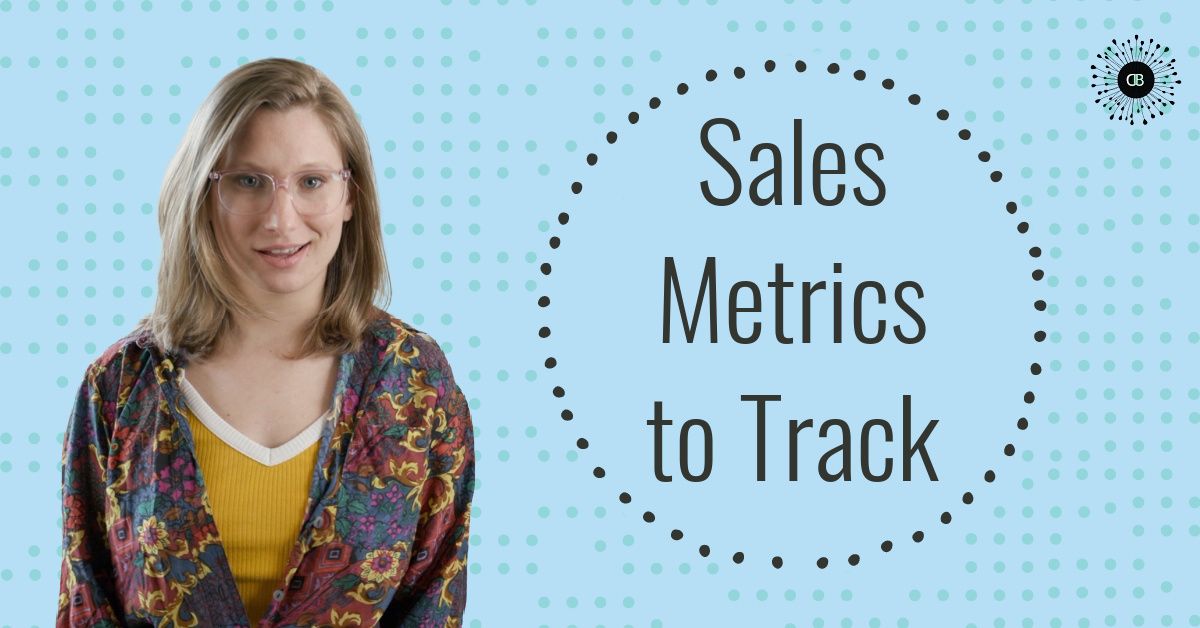Optimizing for sales to your ideal client is one of the fastest and most sustainable ways to grow a brand. The best way to optimize for sales? By tracking your sales analytics metrics of course!
It’s no secret that we’re really into making data based decisions for your business. Like with everything else, we look at your sales metrics holistically. Everything in a business is connected – and it’s especially connected with sales.
Why are Sales Analytics & Metrics Important?
Simply put, holistically analyzing your sales metrics is important because it will tell you how well your business is doing. And paying attention to trends in your data helps you make optimization decisions.
Like tracking your email metrics, tracking your sales metrics will give you incredible insight into what you can be doing better with your sales and marketing, what products are resonating the best with your community, and what areas you’re doing well (and not so well).
Without this kind of information around your business, you’re making decisions in the dark – and you could accidentally end up making a choice that has a negative impact.
Sales Metrics Best Practices
I suggest tracking the below sales metrics weekly or monthly using a spreadsheet. That way you can play with pivot tables and look for trends in your data.
DON’T get caught up in the smaller day to day activity, especially in the beginning, because you will see major fluctuations in your data. Reacting to major fluctuations in your data can lead to making knee-jerk business decisions that aren’t good for the brand long term.
For an example of how we use sales metrics to diagnose real issues, check out my article on solving for the most common sales problem: traffic but no sales.
What are the 13 Sales Analytics Metrics to Watch?
Once you get into the back end of your sales platform you’re going to find that there is an endless amount of things you can track. Over the past several years, we’ve been testing across shopping platforms and analytics to find the best sales metrics that give actionable data to grow. Here’s what we track, why we watch each one, and what they’re useful for.
1 – Total Website Visitors
If your sales platform doesn’t give you this figure, pull it from your Google Analytics traffic. And if you have to use different platforms, make sure the dates are the same. We use this number to calculate a lot of conversions. Your visitor count can help you to indicate growth in traffic compared to sales. Trends here offer a great starting point to root our potential issues with conversion.
2 – Total Sales
This is a pretty basic one, how much in total sales did you bring in during the dates you specified? Not only is this useful to watch for trends in sales growth (yay!), this measurement is one of the most helpful for formulas in your spreadsheet.
3 – Total Number of Orders
How many individual orders did you receive this week? Aside from being good to know, your number of orders is going to help you to understand your conversion rate, average order value, and abandoned cart information. These are three of the most important metrics we work with.
4 – Number of Products Sold
It might seem like tracking the number of products sold feels over the top – BUT – it’s good information to know because you can plan around increasing products sold per order. For most brands, the number of products sold are heavily related to average order value. Compare the number of products sold to the total number of orders. What do you see? Knowing this can help you choose whether you want to prioritize getting more products in carts or potentially raising prices.
5 – Average Order Value is One of the Most Important Sales Metrics
Average order value or AOV is the average a typical customer would spend with your business per purchase. You want your AOV to be higher than the average cost of one product.
To calculate this take your total sales and divide it by the total number of orders for that period.
Obviously, you want this number to increase over time because if you can increase your AOV, your traffic, and your conversion, you’re going to swim in the big bucks.
Tips for increasing AOV
- Use an upsell app to increase product awareness
- Create bundles of products
- Offer coupons on more than one item or free shipping over your AOV goal to incentivize your audience to purchase more
- Don’t offer coupons very often. If you’re doing this right now, wean your audience off your regular coupons.
- Share packaging efficiency goals with your content/on your pages. Plant the idea of buying more than one thing to save on packaging all together.
Extra Tip: Average order value is a helpful metric if you decide to run paid advertising. You can safely assume that any orders that come through your ad will be around that AOV. So as you watch your ad costs, pay close attention to your AOV and make sure you’re NEVER spending more than that (or anything close to this amount).
6 – Conversion Rate
Your conversion rate is the percentage of total website visitors that complete an intended action. For our purposes here, this is if they completed a sale. Your sales program may give you this number, but we create our own calculation on the sheet with this formula to get the best data:
# of orders / # of visitors.
We wrote an entire article about conversion rate already and why this is so important to track. Essentially there are two things that effect your conversion rate: traffic and sales.
If your traffic increases without a sales increase, your conversion rate is going to plummet. If your sales increase without a traffic increase, your conversion rate is going to improve. Ideally you want to see this number between 2-4%. If its lower, it’s a good indication you need some website optimization or an audience update. It your conversion rate is higher than 5%, awesome – it’s time to drive more traffic.
Conversion rate, like average order value, is one of the most important sales analytics metrics for a business. We always ask about it when we start working with people that sell online because we can diagnose the pathway to proper optimization pretty quickly with that information.
If you want to chat about improving your conversion rate and then keeping it stable while you scale, jump on a call with us.
7 – Top Product Sold
Keeping track of your top product will help you know what products stand out best to your audience. This knowledge will help you to better optimize your website and create more products in the future.
If your top product sold is continuously the same product (typical), then you know its a winner for you! You can consider pushing more marketing to that product and work on optimizing your other products in the same way.
If you’re seeing a lot of variability in your top product, take a look at why that could be. It may be how you’re communicating on your marketing channels. If you can identify the cause, you’ll be thinking like a holistic marketer! Optimize whatever it is that’s getting you those sales!
8 – Number of Abandoned Carts
This is the number of people who added something to their cart, but didn’t complete checkout. You need this one to calculate the rate of abandoned carts. It’s also good to watch in general because as things transition in your brand, you shouldn’t see huge differences in the abandoned cart rate (except downward, of course), but you will see shifts in number abandoned carts. It’s a nice growth mechanism.
In some sales programs, like Shopify, this data is automatically offered to you within the platform. For Woocommerce you do need a plugin to look at this data. We suggest considering using Google Analytics Ecommerce Tracking.
9 – Abandoned Cart Rate
The abandoned cart rate is based on the number of abandoned carts as noted above, but it calculates the percentage of people who abandoned their cart, out of the total number of add to carts on your site. The formula for this is:
# of abandoned carts / (# of abandoned carts + # of orders)
Again, we made you a calculation on the spreadsheet for this. You’ll see that the calculation is the number of abandoned carts divided by the total number of orders plus the number of abandoned carts.
10 – Repeat Customer Rate
How many customers come back to buy again?
In the beginning, you want it low enough to indicate that you’re gaining consistent new customers but you’re also providing value, 10-15% is great.
As you grow and your company ages, you want to see that number getting higher, not lower. If you’re seeing around 40% repeat customers after a couple of years, you’re doing great! People are coming back but new people are also coming through.
If you’re seeing a repeat customer rate over 50% you need to increase traffic. Dipping under 20% regularly usually means you aren’t showing up for your customers in a valuable way.
Getting customers to return and place a second, third, fourth, etc. orders is super exciting and should definitely be a sales goal. Repeat customers are loyal fans. And fans bring other loyal fans and new customers!
Most of the time your platform gives this rate to you. But if you need to calculate it, here’s the formula:
# of repeat customers / total number of customers.
11 – Cost of Acquisition (CAC)
How much does it cost to get people to buy your product or service? The ideal CAC is going to completely depend on the price of your product or service. The goal for most brands is to make money over time with repeat customers that place orders above the average order value. Here’s the formula:
total cost of sales & marketing / number of new customers acquired
Here’s a super basic example: You’re spending $300/month on ads and you’re pulling in 10 customers from those ads. Your cost of acquisition is $30 per customer.
If your product costs more than $30, that’s great – you profit out the gate. If not, check in with your repeat customer rate to see if that initial loss is worth it over time for you to keep running those ads.
12 – Return on Investment (ROI)
What marketing are you paying for? Is it paying for itself + some? If not, is it valuable in another way?
Knowing how much you’re investing and what you expect to get in return is an important sales metric to track. It’s simple to look at a number and see if a business is getting a high monetary return on the investment, but sometimes the goal is a bit different than that.
Try looking at this metric holistically where you can by expanding your definition of ROI to include more than just money. Time, value, and attention are all currencies in today’s business world too.
When you are tracking your initiatives keep ROI goals in mind and decide if each initiative is worth the time/money/energy for the business you’re working with.
13 – Profit and Loss
Where are you making money? Where are you losing money? The P&L statement is purely money related and you’re going to write down a pretty basic overview of everything you made and spent in a certain period of time.
We don’t add this one to our regular reporting because it isn’t an efficient use of time all the time. Officially this is a yearly thing because you’ll need it for taxes, but investors will often ask for a quarterly P&L to keep track. (Plus when you do it quarterly, it makes tax time much easier.)
A profit and loss is typically broken down into things like, revenue (types and totals), operating cost (cost of goods sold, research, interest, admin, general expenses), profit (from goods and investments), and paid taxes.
Typically this will give you a very good idea of whether you’re spending too much or not making enough—two sides of the same coin that can severely impact your bottom line.
Thanks for reading! If you have questions, want a template, or just want to have another pair of eyes on your data – please send us an email: info@dandelionbranding.com!
References
https://www.datapine.com/kpi-examples-and-templates/sales
https://www.investopedia.com/terms/p/plstatement.asp
Photo by Silas Köhler on Unsplash




